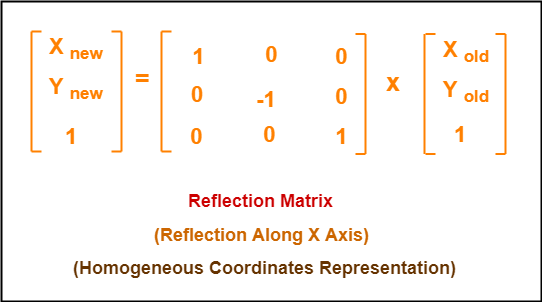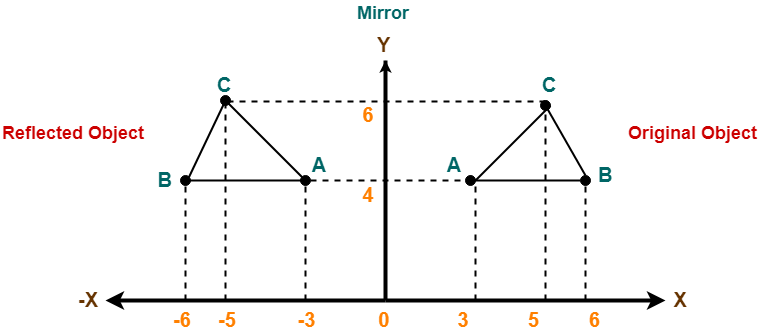3D Transformation in Computer Graphics-
| In Computer graphics,
Transformation is a process of modifying and re-positioning the existing graphics. |
- 3D Transformations take place in a three dimensional plane.
- 3D Transformations are important and a bit more complex than 2D Transformations.
- Transformations are helpful in changing the position, size, orientation, shape etc of the object.
Transformation Techniques-
In computer graphics, various transformation techniques are-

In this article, we will discuss about 3D Translation in Computer Graphics.
3D Translation in Computer Graphics-
| In Computer graphics,
3D Translation is a process of moving an object from one position to another in a three dimensional plane. |
Consider a point object O has to be moved from one position to another in a 3D plane.
Let-
- Initial coordinates of the object O = (Xold, Yold, Zold)
- New coordinates of the object O after translation = (Xnew, Ynew, Zold)
- Translation vector or Shift vector = (Tx, Ty, Tz)
Given a Translation vector (Tx, Ty, Tz)-
- Tx defines the distance the Xold coordinate has to be moved.
- Ty defines the distance the Yold coordinate has to be moved.
- Tz defines the distance the Zold coordinate has to be moved.

This translation is achieved by adding the translation coordinates to the old coordinates of the object as-
- Xnew = Xold + Tx (This denotes translation towards X axis)
- Ynew = Yold + Ty (This denotes translation towards Y axis)
- Znew = Zold + Tz (This denotes translation towards Z axis)
In Matrix form, the above translation equations may be represented as-

Also Read- 2D Translation in Computer Graphics
PRACTICE PROBLEM BASED ON 3D TRANSLATION IN COMPUTER GRAPHICS-
Problem-
Given a 3D object with coordinate points A(0, 3, 1), B(3, 3, 2), C(3, 0, 0), D(0, 0, 0). Apply the translation with the distance 1 towards X axis, 1 towards Y axis and 2 towards Z axis and obtain the new coordinates of the object.
Solution-
Given-
- Old coordinates of the object = A (0, 3, 1), B(3, 3, 2), C(3, 0, 0), D(0, 0, 0)
- Translation vector = (Tx, Ty, Tz) = (1, 1, 2)
For Coordinates A(0, 3, 1)
Let the new coordinates of A = (Xnew, Ynew, Znew).
Applying the translation equations, we have-
- Xnew = Xold + Tx = 0 + 1 = 1
- Ynew = Yold + Ty = 3 + 1 = 4
- Znew = Zold + Tz = 1 + 2 = 3
Thus, New coordinates of A = (1, 4, 3).
For Coordinates B(3, 3, 2)
Let the new coordinates of B = (Xnew, Ynew, Znew).
Applying the translation equations, we have-
- Xnew = Xold + Tx = 3 + 1 = 4
- Ynew = Yold + Ty = 3 + 1 = 4
- Znew = Zold + Tz = 2 + 2 = 4
Thus, New coordinates of B = (4, 4, 4).
For Coordinates C(3, 0, 0)
Let the new coordinates of C = (Xnew, Ynew, Znew).
Applying the translation equations, we have-
- Xnew = Xold + Tx = 3 + 1 = 4
- Ynew = Yold + Ty = 0 + 1 = 1
- Znew = Zold + Tz = 0 + 2 = 2
Thus, New coordinates of C = (4, 1, 2).
For Coordinates D(0, 0, 0)
Let the new coordinates of D = (Xnew, Ynew, Znew).
Applying the translation equations, we have-
- Xnew = Xold + Tx = 0 + 1 = 1
- Ynew = Yold + Ty = 0 + 1 = 1
- Znew = Zold + Tz = 0 + 2 = 2
Thus, New coordinates of D = (1, 1, 2).
Thus, New coordinates of the object = A (1, 4, 3), B(4, 4, 4), C(4, 1, 2), D(1, 1, 2).
To gain better understanding about 3D Translation in Computer Graphics,
Next Article- 3D Rotation in Computer Graphics
Get more notes and other study material of Computer Graphics.
Watch video lectures by visiting our YouTube channel LearnVidFun.





















